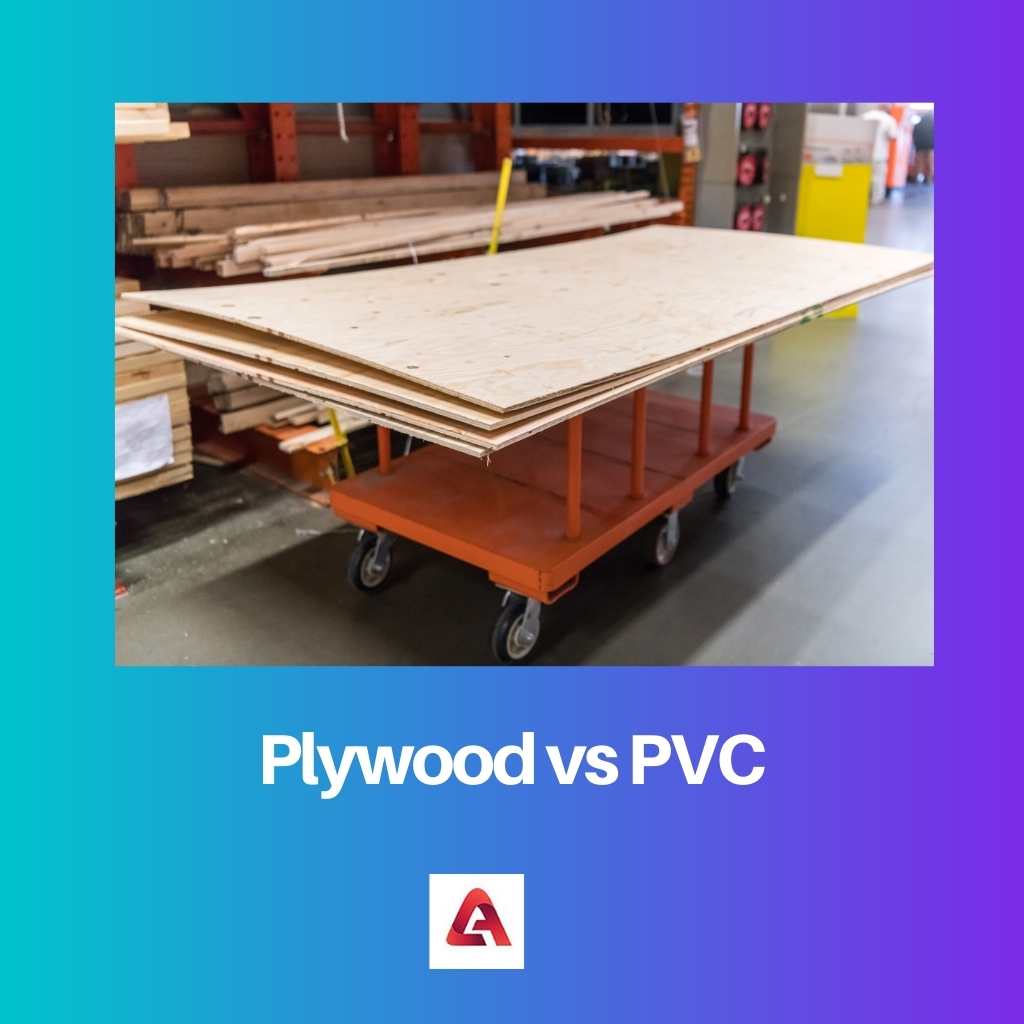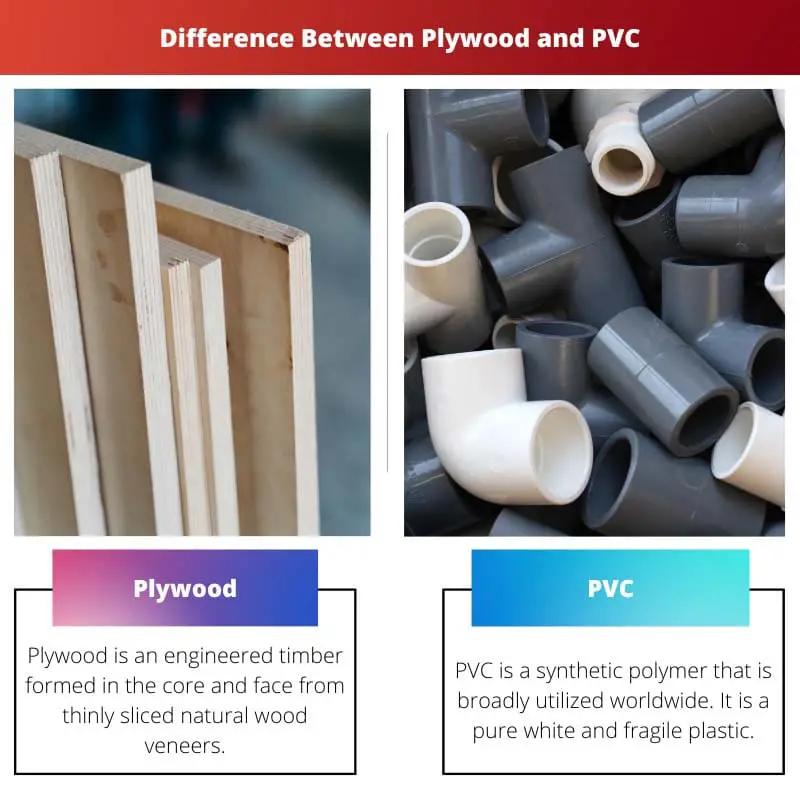Plywood and PVC (Poly Vinyl Chloride) are the two important materials that are used to make different items in our houses, offices, and other places.
When we think of renovating our house especially kitchen the materials that first come to our mind are Plywood and PVC. Cupboards, furniture, and other objects for the home or business are commonly made from Plywood and PVC.
They’re most commonly employed in kitchen remodels. Although both Plywood and PVC play a significant role in any renovation or remodeling project, as compared to Plywood PVC boards are more widely used.
Key Takeaways
- Plywood consists of multiple layers of wood veneer glued together, while PVC (polyvinyl chloride) is a synthetic plastic polymer.
- Plywood offers greater structural strength and durability than PVC but can be susceptible to water damage and pests.
- PVC boasts water resistance, chemical resistance, and ease of maintenance, making it more suitable for indoor and outdoor applications than plywood.
Plywood vs PVC
Plywood is an engineered wood product made by gluing together thin layers of wood veneer with the grains of each layer perpendicular to the adjacent one. PVC, or polyvinyl chloride, is a type of plastic that is used in a wide range of applications, including construction and plumbing.

Peeler woods are used to make Plywood. Spinning wood logs across their horizontal plane peels fine layers from it.
To make a Plywood panel, the layers of veneer produced from this procedure are cut to the necessary proportions, parched, mended, bonded together, and heated in a press at 140 °C (284 °F) and 1.9 MPa (280 psi).
Plywood can or can not be flat and suitable for visually appealing interior wood components, based on the quality. For kitchen design, certain varieties of Plywood can be painted and designed to look attractive.
PVC is a cost-effective, flexible plastic that is used in a wide range of products in the building, renovation, medical, electronic goods, automotive industry, and other industries, including pipework and siding, medical supplies and ducting, electrical wiring, etc.
PVC can be as stiff as commercial pipes, as supple as bubble wrap, or as thin and supple as wall covering. It could also be entirely transparent or color-matched to any specified hue.
Comparison Table
| Parameters of Comparison | Plywood | PVC |
|---|---|---|
| Durability | Less durable as compared to PVC | More durable |
| Flexibility | Less flexible as compared to PVC | More flexible |
| Invented by | Immanuel Nobel | Henri Victor Regnault and Eugen Baumann |
| Raw material used | Softwood, hardwood, or a combination of both | Salt and oil |
| Moisture resistance | Less resistance to moisture as compared to PVC | More resistance to Moisture |
What is Plywood?
Plywood is an engineered timber formed in the core and face from thinly sliced natural wood veneers.
In these core veneers, the wood grains of adjoining layers are turned or rotate up to 90 degrees in relation to one another and stick into layers one on top of the other.
Plywood’s structural rigidity and stability come from the cross stacking of neighboring layers. To make Plywood, these veneers are glued together, compressed under tremendous pressure, and then heated.
Plywood is an adjustable, adaptable, and highly usable building substance that is commonly used to create furniture, cupboards, bookcases, and closets, among other things.
If we look into the availability of Plywood there are different varieties of Plywood available, a few types of Plywood are listed below:
1. Plywood made of softwood- Softwood Ply is also referred to as SPF as it is made from the trees such as spruce, pine, and fir, it is employed for building and cladding.
2. Plywood made of hardwood: Hardwood Ply is rigid, tough on the surface, and is resistant to change. It is used to support a lot of load and pressure.
3. Marine Plywood: It is a kind of Plywood that can withstand dampness, humidity, and wet conditions.
Plywood also has a variety of feature that makes it unique from other wood materials, some of its features are as follows:
– Plywood is extremely strong and stable.
– Plywood possesses a great impact tolerance.
– Plywood is resistant to flames, moisture, temperature, and chemicals.

What is PVC?
PVC is a synthetic polymer that is broadly utilized worldwide. It is a pure white and fragile plastic (prior to the introduction of plasticizers). PVC was originally synthesized in 1872 and widely manufactured by B.F.
Goodrich Corporation in the 1920s, making it older than most polyethylene. Several other popular polyethylenes, on the other hand, were only created and economically efficient in the 1940s and 1950s.
It’s most employed in construction, but it’s also utilized for signs, pharmaceutical uses, and clothing fiber.
Eugen Baumann, a German chemist, created PVC ‘accidentally’ in 1872. He placed vinyl chloride gas enclosed in a tube to daylight, which resulted in the formation of PVC, a white solid.
Friedrich Klatte, a German chemist, got the initial patent for PVC in 1913 for his technique for polymerizing vinyl chloride utilizing sun rays.
By the end of World War I, Germany had developed a range of flexible and stiff PVC goods to substitute metal that can withstand corrosion.
PVC mainly comes in two varieties or forms, which are as follows:
1. Flexible PVC: It is made by adding suitable plasticizers to PVC, that lowers the crystalline nature of the material. The plasticizers function as lubricants, making the polymer clearer and more pliable. PVC-P is another name for this kind of PVC.
2. Rigid PVC: It is also known as unplasticized PVC, this type of PVC is rigid and economical that is resistant to the effect of moisture, temperature, acids, and corrosive conditions.
Nowadays, PVC has replaced numerous materials in many fields, due to its unique features. Below is the list of some features of PVC that adds to its unique qualities:
-PVC has a high thickness relative to most polymers.
-PVC is inexpensive and easily obtainable.
– Rigid PVC has high strength and endurance rating.

Main Differences Between Plywood and PVC
1. Plywood is more susceptible to termites and insects attack as compared to PVC.
2. Plywood was introduced in the year 1865, whereas PVC was introduced in the year 1872.
3. There are more color options in Plywood as compared to PVC.
4. Plywood is heavier as compared to PVC.
5. In comparison to Plywood, PVC has a much broader range of applications.

Reference
- https://pubs.rsc.org/en/content/articlehtml/2019/ra/c9ra02848j
- https://link.springer.com/article/10.1007/s00107-020-01557-2
